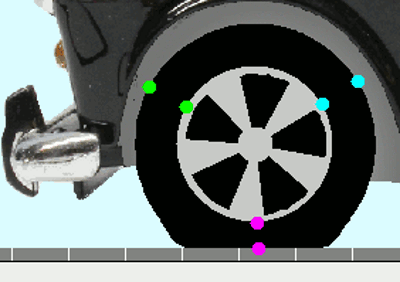|
|
|
|
News The Project Technology RoboSpatium Contribute Subject index Download Responses Games Gadgets Contact <<< Acceleration Java-Applet rolling friction >>> Rolling frictionTerminologyFriction is the inhibition of movement.Rolling friction or rolling resistance is the resulting force occurring while an object rolls on a flat surface without slipping. The force is caused by the deformation of the rolling object or the surface. Where is: FR - rolling resistance force, cR - rolling resistance coefficient, FN - normal force In practiceHave you ever played with plasticine? So you will have noticed that it is very hard when taking out of the packing. You have to work hard to be able to knead it. After some minutes of deforming, the plasticine becomes more and more flexible. You will have noticed that it heats up during the procedure and that the warming is more acute, the harder you press the plasticine. The reason for this behavior is the internal friction. By pressing the plasticine, you are moving the molecules against each other. The effect of this kind of movement can be explored by rugging your hands, which means you are moving the molecules of your skin's surface against each other. You will notice that your hands are heating up. By friction, mechanical energy (=movement) is turned into thermal energy (=heat).That deformation takes place while the tire of a car rolls over the street can be observed better, the less it is pumped up. The lower the pressure, the more it is flattened at the lower half, while the upper half is still roundly. If the tire starts rolling, every point of the tire surface is alternately at the lower or upper half. Like the plasticine, the tire is permanently kneaded. A bicycle or a car with flattened tires is harder to push than with round tires. The additional work is needed to overpower the additional friction. 
Deformed tireWhile rolling, the colored markings reside alternately at the upper or lower half of the tire. Because of the fact that the tire is flattened at the lower half, the distance between the pairs of markings is changing permanently. At the left picture, the pink markings are closer to each other than the blue and green markings. It becomes evident that the tire material is kneaded.Not only tires are rollingand not only the tires are deformed! If a steel ball is rolling on a rubber plate, you will see that the rubber is more deformed than the rolling object. In principle both - the rolling object and the surface are always deformed slightly. Even a crystal ball rolling on a glass plate is not free of rolling resistance. The deformation is just too small to be seen with your naked eye, because it is smaller the harder the materials are. The rolling resistance is always lower than kinetic friction which will be examined later. That is the reason why ball-bearings made out of steel or ceramic are used to reduce friction. Ball-bearings can be found at the wheels and inside the gearbox and engine. You can prove the excellence of the wheel bearing when lifting the car and jogging the tire. The longer it rotates, the better the bearing is.At the following page you will find a Java-application demonstrating the deforming of a tire while rolling. The plot shows the distance between a pair of markings at the rim and the edge of the tire. You will see that the deformation is stronger the lower the tire pressure is. The plot shows that the tire is not only compressed but also stretched. The distance becomes temporarily greater than the normal distance at the upper half of the tire. Enlarge the view and see how the markings slip temporarily along the street. To make this fact visible, there are vertical lines attached to the street. Tires are always stressed and low pressure increases the stressing. The consequence is a increased warming until melting (=blowout). So why not using tires being as hard as possible?Because friction can be useful, too! We will examine more about that at the chapter "static and kinetic friction".<<< Acceleration Java-Applet rolling friction >>> News The Project Technology RoboSpatium Contribute Subject index Archives Download Responses Games Links Gadgets Contact Imprint |
|
|